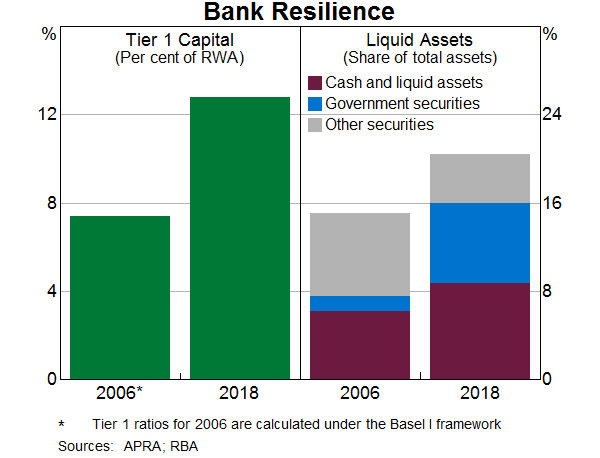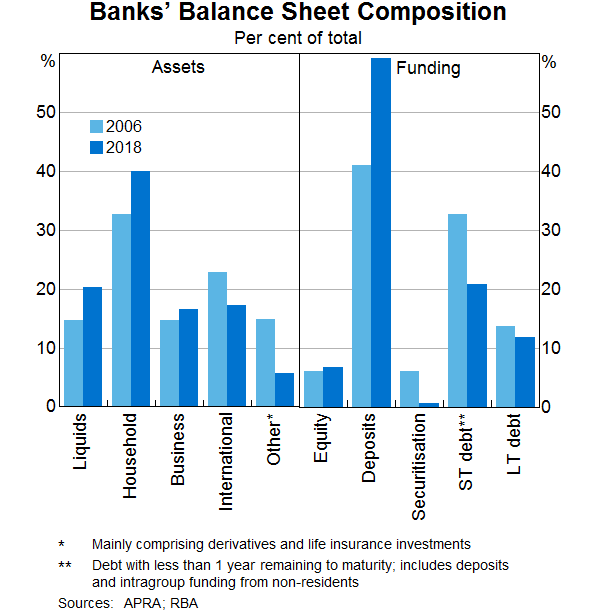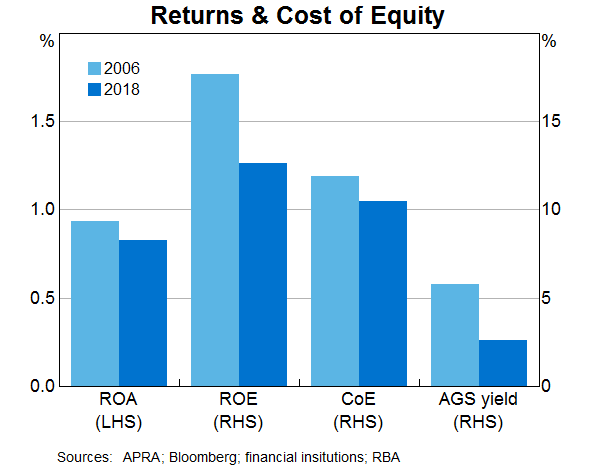Thank you to the organisers for the opportunity to present to you today. Banks have a central role in facilitating activity in modern economies. While that role is just as important today as it was prior to the financial crisis, the nature of banking has changed. And given developments in technology, data and competition, banking will need to continue to evolve. Today, I am going to discuss these changes in banking, past and prospective.
To put these changes in context, first I want to consider the special role that banks play in the economy. I will then focus on how banks have changed in Australia since the financial crisis, and outline some of the issues facing banks today that could see banking change in the coming years (my remarks for Australia apply to all Authorised Deposit-taking Institutions, ADIs, but to fit with the international literature I will use the term ‘banks’ and also because the word banks rolls off the tongue more easily). While the Australian banking system remained well capitalised and profitable through the financial crisis and by and large continued to service the economy, it was still affected and the lessons learned internationally have resulted in important changes to Australian banks.
What gives banks their special role?
Four characteristics jointly define why banks have a special role in the economy today:
- they accept deposits, which become risk-free liquid assets for households and businesses
- they engage in maturity and liquidity transformation, using (mostly short-term) liquid deposits and debt to make long-term illiquid loans
- they play a central role in the payments system
- they have expertise in credit and liquidity risk management, having a long history and ongoing relationships that generate private information about customers.
The first three of these defining characteristics all relate to three key benefits that come from public authorities. In particular, banks have: (i) the ability to accept deposits; (ii) an account at the central bank; and (iii) access to emergency central bank liquidity. The three benefits provide banks with a special role in the economy.
Bank deposits become a risk-free asset for households and business in Australia because they have an effective government ‘guarantee’ (up to a limit) and receive the first claim on banks’ assets.[1] Bank deposits are liquid because banks, in addition to the cash banks hold for depositors’ physical withdrawals, have accounts at the central bank which enable their customers to make direct payments to the customers of other banks.[2] It is because banks have accounts at the central bank that they are central in the payments system. Further, even in tumultuous times, deposits are liquid because of banks’ access to convert (potentially illiquid) assets into highly liquid deposits at the central bank and, in the worst case, because the Financial Claims Scheme pays out deposits in a timely manner. These policies give depositors the confidence that their deposits are safe and can be withdrawn on demand.
These benefits help to mitigate the core risk of banking: maturity and liquidity transformation creates the risk of a run. With access to stable deposits and central bank liquidity, banks are able to safely do more maturity and liquidity transformation.
These three benefits go hand in hand with banks’ critical role in taking deposits and intermediating and financing economic activity. Because of this role, banks are subject to prudential regulation. Prudential regulation has benefits and costs. In economics, we typically try to equate marginal costs and benefits when determining how much of something we should have.
From society’s perspective, prudential regulation has benefits in that it reduces the risks to depositors and to the economy from bank failures. But there are also ‘costs’ to more regulation, notably that it makes banks’ intermediation more expensive. To calibrate the optimal amount of regulation, policymakers try to balance these costs and benefits.
We can also think of the costs and benefits of prudential regulation from the perspective of banks. For banks, regulation can increase their costs. But it also provides banks with significant benefits. Even in normal times, because they are prudentially regulated, banks can take in deposits that are a relatively cheap source of stable funding. But the benefits are even greater in financial turmoil, when having deposits that are relatively sticky and access to central bank liquidity is particularly valuable.
The value of banks’ special role
Globally, the financial crisis delivered a severe shock to the banking system, and to the economy, that far exceeded what was generally thought likely or even possible. Before the crisis, it was widely thought that banks had become more sophisticated in managing their risk and that financial and macroeconomic volatility had declined. As a result, a severe financial shock was judged to be exceptionally unlikely. But then the financial crisis came along, which internationally resulted in bank failures and severe recessions. This led to a re-evaluation of how likely and extreme banking shocks could be. Globally, authorities recognised that the benefits of tighter prudential regulation – avoiding banking crises – would outweigh the costs.[3]
Similarly, from the banks’ perspective, it became apparent that the benefits that came with their special role in the economy were even greater than previously appreciated, because shocks to the financial system, and hence the impact on their balance sheets, could be more severe than was previously thought likely. Indeed, in some countries the benefits of being a bank were so great that some non-banks converted to being a bank to get those benefits.[4]
The international reassessment of banking regulation led to the ‘Basel III’ reforms. The reforms focused on improving banks’ resilience, limiting banks’ maturity transformation and ensuring that they improved their credit assessment and management of risk.
Recent changes in Australian banks
Despite the extreme shock globally, the Australian banking system performed remarkably well through the crisis. In Australia, there was significant fiscal and monetary stimulus, and various measures were enacted to support the banking system, and there was also a bit of luck. However, the good performance of the Australian banks, to a large extent, reflected the strength of prudential regulation prior to the crisis and banks’ own management of risks. But given the lessons learned internationally, it was apparent that there were still improvements to be made in Australian banking.
The Basel III reforms have been adopted in Australia, on or ahead of schedule, strengthening a prudential regime that was already tighter than global minimum standards. The reforms encouraged banks to put greater emphasis on incorporating the cost of capital and liquidity into all aspects of their operations.
Tier 1 capital ratios have increased by 50 per cent since 2006, with most of this being CET1 capital (Graph 1). At current levels, banks’ Tier 1 capital ratios are estimated to be well within the range that research has shown would have been sufficient to withstand the majority of past international banking crises.[5]

A consequence of this has been a reduction in risk-taking. Banks sold some of their higher risk assets that were not providing sufficient rates of return. Notably, Australian banks have pulled back from international banking activity in the United Kingdom and Asia, where the returns had been disappointing and had often not met banks’ cost of capital (Graph 2). They also expanded their exposure to mortgage lending, which requires much less capital because of the collateral protecting these loans.[6] Most of the major banks have also sought to divest their life insurance and wealth management operations. These divestments were precipitated by changes in capital rules that required more capital to be held to support intra-group investments. But they also reflected that these investments had failed to deliver the anticipated benefits, including from cross-selling, and an appreciation of the non-financial risks that they involved.
The introduction of liquidity regulations – the Liquidity Coverage Ratio (LCR) and Net Stable Funding Ratio (NSFR) – contributed to a substantial rise in the banks’ liquid asset holdings, to around 20 per cent of total assets (from 15 per cent pre-crisis) (Graph 1). The vast majority of this increase has comprised High Quality Liquid Assets (HQLA), in particular, government securities.
The liquidity regulations contributed to a reduction in liquidity and maturity transformation. This has substantially changed the composition of banks’ liabilities. Banks have significantly reduced their use of (more flighty) short-term debt, while increasing their use of (sticky) domestic deposits (Graph 2). By applying transfer pricing across their whole businesses, banks are now seeking to ensure that all lending decisions take account of the extent of liquidity or maturity transformation.

The regulatory changes and banks’ better recognition of financial risks and returns have restricted growth in Australian banks’ (headline) profits since 2014. The divestment of their wealth management businesses reduced total profits. However, even focusing on return on assets (ROA), profitability has declined by more than one-fifth since the financial crisis (Graph 3). Two important contributors have been the increased holdings of (safer but lower yielding) HQLA and a more general decline in risk-taking and hence reward. The fall in profitability has been even larger (about one-third) when measured by return on equity (ROE), because of the increase in banks’ equity outstanding.
However, the decline in profitability does not equate to reduced costs of financial intermediation for customers. Rather, the spread between lending rates and funding costs (or the cash rate) has increased a little. This combination of higher costs to customers and lower profits to banks reflects the (anticipated) costs of tighter prudential regulation.[7]

Banks’ absolute cost of equity (COE) has also declined. The decline in absolute COE has, however, been less pronounced than the fall in risk-free rates (Australian Government Security (AGS) yields). So the risk premium on banks’ equity has actually risen. This is consistent with equity investors having revised up their assessment of the riskiness of investing in banks, even as banks have been forced to deleverage and hold more liquid assets.
Since ROE has fallen by more than COE, banks have become less valuable. One way to think about this is that, since banks are now obliged to hold more equity (that is, they are less leveraged), they generate a lower expected return on equity in excess of the risk-free rate. If the cost of financing a bank were independent of the mix of debt and equity, that is, we lived in a world where the Modigliani-Miller theorem held,[8] then issuing more equity would reduce the cost of the bank’s debt and equity, so keeping the total cost of funding unchanged. There are many reasons why the Modigliani-Miller theorem may not hold, including government protection of banks’ deposits. This means that deposits don’t become less risky as the banks issue more equity, and so the cost of debt doesn’t decline. But with the bank issuing more relatively expensive equity, the cost of funding banks rises overall, which explains why they become less profitable when they are obliged to reduce their debt-equity ratios.
Despite the decline in ROE, Australian banks continue to generate ROE well in excess of their risk-adjusted COE. They trade at price-to-book ratios exceeding one, higher than banks in many other countries around the world, highlighting the value that investors still see in Australian banks.
Prospective drivers of further change in Australian banks
While the past decade has seen substantial changes in banking in Australia, there are several issues facing banks that could potentially lead to even greater change in coming years. The first is the general increased access to, and ability to process, vast quantities of data. This is facilitating the emergence of new, technology-driven competitors to banks which could potentially impact their dominant position in the financial system.[9] A second is the impact of tighter regulation on banks. A third is expectations for banks’ obligations to the community.
A substantial influence on banking at the moment is the rapid pace of technological change. We are currently seeing a massive increase in the availability of, and ability to process, data. This could erode, or maybe even eradicate, banks’ historical advantage in credit risk assessment. There are two parts to this: regulatory changes mean that banks’ private customer data can be made available to others and, second, that non-banks have some data that is useful for banking business.
The first part is the Consumer Data Right (CDR) and Open Banking. The CDR makes it clear that the consumer owns their own data and Open Banking provides bank customers with the ability to share their account data with other institutions, including non-banks.[10] Using these data, a non-bank could, for example, suggest accounts or cards that better suit a customer’s needs or use the information for detailed credit assessment. In addition, Comprehensive Credit Reporting (CCR) will provide (bank and) non-bank lenders with greater information about potential borrowers’ credit history.[11]
The second part is non-banks’ data that are becoming more valuable for ‘banking’ services. Much of this data is collected by ‘big tech’ firms such as Google, Apple and Facebook. For example, PayPal and Amazon have substantial data on the sales of their merchant customers, while social networking interactions can be used to predict borrowers’ commitment to repay their loans.[12] Technology firms for which collecting and analysing data is in their DNA are a new type of competitor for banks that have historically struggled to take full advantage of the private data they hold. How well individual banks respond to technology challenges will no doubt influence their relative success.
Technological changes in payments are also challenging banks’ core role in facilitating payments. To date, this erosion has been most apparent in emerging market economies where payments systems were not meeting customers’ needs. For example, in China and several African countries, online marketplaces or mobile phone companies have come to dominate payments (largely bypassing the banks). However, in Australia, and other developed economies, existing electronic payment systems (including new real-time payment systems such as Australia’s New Payments Platform (NPP)) are already meeting customers’ needs. Still, new payments providers engaging with banks and card companies could reduce the banking systems’ revenue from the payments system.
Where banks have provided poor service, such as in cross-border transfers, new competitors may capture market share. This is already occurring with specialist firms undercutting the banks’ very wide spreads in cross-border payments. Cross-border payments are also a potential entry point for ‘stablecoins’ which could be used to make low-cost payments across borders, completely bypassing the banking system.[13]
A second issue for banks is the impact that tighter regulation has on the cost of intermediating borrowing and saving. Tighter prudential regulations, such as holding more capital and liquid assets, was anticipated by regulators to increase the cost of intermediation.[14] These expected higher costs were taken into account in calibrating regulations and are judged to be appropriate given the reduced chance of financial crises. But higher costs for banks can push more borrowing to non-bank financial institutions or into capital markets. The share of credit intermediated by non-banks is currently small in Australia and so there are limited implications for financial stability. But if it were to grow significantly, we would have to carefully assess what this might mean for financial stability.
A third issue for banks comes from expectations in terms of their obligations to the community. Banks will need to adapt to a range of reforms designed to strengthen governance and culture at financial institutions. These should lead to less and better-managed non-financial risk. The measures include the Banking Executive Accountability Regime (BEAR), the Australian Prudential Regulation Authority’s (APRA) proposed standards for how variable remuneration is structured and the response required to shortcomings identified by the Financial Services Royal Commission. While these measures require banks to adapt, they will make banks more resilient, increasing their chance of responding to new competitors.
Final remarks
Summing up, while banks are facing various challenges, their special role in the economy gives them several advantages. Deposits are overall a lower cost, and stable, form of funding. And providing depositors with a liquid asset puts banks at the centre of the payments system and gives them a connection to customers.
Banks have adapted following the financial crisis. And they will need to continue to evolve given the challenges they will continue to face in the coming years. Greater availability of data reduces one of banks’ advantages. And changes in technology introduce a different type of competitor. For now, the banking system remains core to modern economies. Australian banks in particular serve critical functions in the Australian economy by providing credit intermediation and more generally facilitating economic activity. Australian banks are profitable and resilient and a strong banking sector has contributed to Australia’s extended run of economic growth. It’s hard to imagine a modern economy without a banking sector. The eight largest Australian banks can trace their history back, on average, over 140 years. But what role today’s individual banks play in the provision of banking services in the coming decades will depend on how they adapt to the challenges they face today.












